

Features
Fiber Internet Is The Key To A Sustainable Internet
With the growing concern over the future of the Earth and the damage that we are doing to the environment, we are all looking for ways to improve our habits to be more sustainable. One of the ways that you might not have thought about yet is your internet. While the internet itself within your home might not be damaging to the environment, since it puts out very little in the way of microwave emission, there is always more at play than what is happening within your network. The Internet produces 300 million tonnes of carbon each year, which has a substantial impact on the environment and makes climate change worse.
One consideration that might work for you is to switch to fiber internet if you can. Fiber internet has been shown to be a more environmentally friendly option for internet service.
North Carolina State University wrote a great article on the role of fiber internet and its impact on sustainability.
“These new networks have the potential to move our state towards a more sustainable future. They can change how work gets done, and reduce the need to travel or own a car. Abundant bandwidth creates new opportunities to develop sensors to track and communicate environmental indicators, like how warm it is in your bedroom or how much nitrate is in the water coming out of your faucet,” they write.
What is Fiber?
Fiber internet operates through the use of fiber optic cables. These are run separately throughout neighbourhoods and then typically wired to an ONT box within your house. An ONT box is like a modem, but smaller, bringing the internet signal into your home. Fiber optic technology is a very thin type of cable that is also incredibly powerful, transmitting uninterrupted signals effortlessly. Fiber carries more information per mile than older technologies do.
Fiber is the newest form of internet to take the scene. It is also a greener alternative to many of the other forms of online technology. Where DSL was able to make use of existing phone lines and cable internet uses the same cable connections as a television set, fiber is something different. It is separate from the old framework, which allows it to make use of modern technology effortlessly.
You can look for the recommended router for Verizon Gigabit FiOS internet if Verizon FiOS is available to you. Other companies also carry fiber, however, so see what is nearby and then look for a router that will work with it. Do not just assume that any wireless router will work with your fiber provider.
Fiber’s Impact
Fiber’s impact happens in a couple of different places, really. The first is that it requires fewer materials than DSL or cable internet. Both DSL and cable use copper wire to transmit the data across the internet. Copper mining has been shown to be incredibly dangerous and harmful to the environment. Getting rid of the need for copper will reduce your overall carbon footprint. Environmental News Network has praised this new technology for its contributions to lowering our environmental impacts. Think of all of the copper wire that might be spared or recycled as a result.
Fiber internet is also more sustainable when it comes to natural elements. Fiber will not crash the way that DSL or cable do when there are thunderstorms powerful enough to wipe out thousands of connections. Fiber is hardy and rarely requires any kind of repair. It also requires less energy than is used for copper wire transmissions. Since fiber requires less energy, it also does not need to be cooled to the same extent that other types of internet do, meaning there are fewer air conditioning units on the job to keep the system cool.
Other Impacts
Beyond the primary impacts of fiber internet, let’s look at secondary impacts that it has. If fewer repairs are required for a fiber connection, that means fewer repair people on the job. There will be fewer people driving from site to site, emitting carbon all along the way, since they are simply not needed. When repairs are needed, they are done 67% faster than copper wire equivalents.
Additionally, fiber can keep up with the increasing demands for bandwidth and streaming. There is no need to have additional wires installed or updates in order to increase the speed of the fiber internet. Instead, it just maintains its speed regardless.
What you need
To get started with fiber internet, you will need to first make sure that you have it available to you. Fiber optic cables have not been run all over towns just yet, though the availability is increasing as the demand gets higher. Since fiber uses an ONT box, it does not require a modem, but you will still want a wireless router to transmit the signal across your network.
Fiber is just one way that you can make a difference and reduce your carbon footprint, but the impact is substantial. As more people make the choice to switch, we are giving the environment a better chance.
Fiber Internet is a Sustainable Alternative to Traditional Online Connections
There are a number of ways that businesses can access the Internet, but some of them leave a larger carbon footprint than others. You will need to be aware of the greener ways to provide Internet service. Fiber internet connections are a better option for sustainable companies.






















